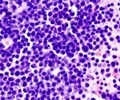Two new studies show that varied genetic aberration lead to NF-êB activation in multiple myeloma, a cancer of the blood plasma cell that produces antibodies to help the body fight off infections in the body.
The new study gives us an insight into the molecular mechanisms that cause abnormal NF-êB activity in MM tumor cells and emphasizes the relevance of the NF-êB signaling pathway as a target for MM therapy.Previous research had connected that abnormal activation of the NF-êB signaling pathway as a key event in MM pathology. NF-êB target genes are known to be involved in cell proliferation and cell survival. Although there is important overlap and interaction between them, there are two separate pathways that lead to activation of NF-êB, the classical pathway and the alternative pathway.
Constitutive activation of NF-êB to block apoptosis has been implicated in various types of cancer, but the molecular mechanisms involved are not well understood. Two separate research groups used a variety of sophisticated genomic techniques to examine mutations in hundreds of MM patient samples and cell lines to identify mutations that impact NF-êB activation.
Dr. Louis M. Staudt from the National Cancer Institute led a research group who revealed the importance of both the classical and alternative NF-êB pathways in MM pathogenesis. Most MM patient samples examined exhibited NF-êB pathway activation via diverse genetic abnormalities.
Importantly, targeted disruption of the classical NF-êB signaling blocked myeloma proliferation and induced cell death. “These genetic and functional data provide a molecular framework for the rational development of NF-êB pathway inhibitors for the therapy of MM,” offers Dr. Staudt.
In a separate study, Dr. Rafael Fonseca, from the Mayo Clinic Arizona, and colleagues report mutations in several genes that result in constitutive activation of the alternative NF-êB pathway.
Advertisement
Taken together, results for these studies define diverse mutations that lead to pathological activation of NF-êB signaling in MM and describe a shift of plasma cells from dependence on the microenvironment to an environment-independent state during progression of MM.
Advertisement
Source-Eurekalert
BIN/J






